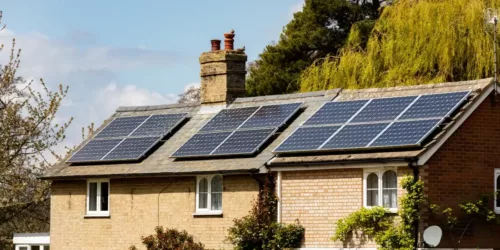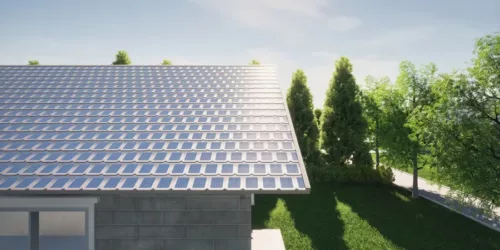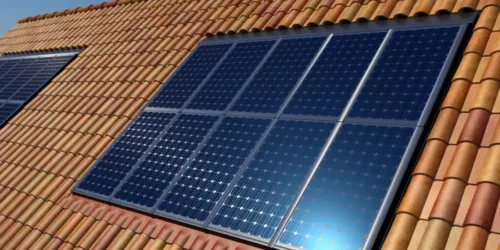Solar Panel Costs in 2024
- Typical solar panel prices per type
- How much solar panels are in the UK
- How long it takes to offset solar panel costs
Solar panel costs were reduced by 82% between 2010 and 2019. With over 1 million households across the UK benefitting from solar panels, it’s no wonder that more people are turning to this form of renewable technology to help lower their energy bills. Despite what solar panels cost, you can make use of free electricity and export anything unused back to the national grid.
This article will explain solar panel costs, from individual units to typical installations per house type. It will also go over what factors affect the price you pay and how you can earn money back. The last thing to cover is the buyback period, which will be reduced with the savings you make with your solar array.
Interest in solar panels already? Use our quote comparison tool to find out how much you'd pay. It only takes a minute.

What's On This Page?
Click the links below and head straight to a specific section of the article.
What Different Types of Solar Panel Are There?
Solar panels come in many types, but the most prolific installation for a home is the standard on-roof traditional solar panel. These are the most efficient at providing energy for the home. Solar panel costs depend on which type you go for, as this affects how much electricity they generate.
Solar panels come in the following types:
Monocrystalline
Polycrystalline
Thin-film
In-roof
Flexible
Monocrystalline Solar Panels
Created with a single silicon crystal in every cell, a monocrystalline solar panel costs more than a polycrystalline panel, but this is because it is more efficient and can generate more power. Characterised by their black cells and curved edges, these panels are best for roofs without much space to maximise your return.
Polycrystalline Solar Panels

These are the cheaper cousins of monocrystalline panels as they are formed with multiple silicon crystal fragments across cells that are moulded together. They aren’t as efficient, so more are needed to produce the same amount of electricity as monocrystalline panels. A polycrystalline solar panel costs much less because they’re easier to manufacture. They’re blue in colour and have straight edges.
Thin-Film Solar Panels
Thin-film panels are less durable and less efficient, but they are extremely lightweight and portable. Most often used in space, these solar panels cost a lot less than other types, but they are not suitable for home installation.
In-Roof Solar Panels
As opposed to on-roof panels, in-roof (or integrated) solar panels sit flush with your other roof tiles. They replace part of your roof and make it less obvious that they’ve been fitted. This comes with the downside of not having efficient temperature regulation, which affects their efficiency slightly. Solar panel costs for in-roof technology works out much cheaper than a traditional on-roof system.
Solar Roof Tiles
Not actually solar panels, solar roof tiles have the same technology integrated into them and are designed to replace your roofing tiles. Regarded as stronger than other kinds of roof tile, these are less efficient, but are the perfect option for people who dislike the look of traditional on-roof solar panels. The downside is that compared to solar panel costs, solar roof tiles are much more expensive.
Flexible Solar Panels
Similar to thin-film technology, flexible solar panels have comparable efficiencies to traditional on-roof solar cells. Able to flex around obstacles and be moved from different surfaces, these lightweight panels are more suited to boats, motorhomes and caravans. They aren’t usually used for home installations. A highly efficient flexible solar panel costs more.
How Much Do Solar Panels Cost?
There are many factors that affect solar prices. Not only will the size of your roof affect what you pay, but how much power you require as well. Bigger households will have more electricity demand, which will drive up the price, but smaller homes will be much cheaper.
You can see typical solar panel costs for the various types in the interactive graph below.
In-roof solar comes out on top as the cheapest method, but you can lose up to 10% efficiency compared to monocrystalline types, which are the most widely used across households. Polycrystalline panels are less expensive, but they also suffer from up to 7% less efficiency. To lessen your solar panel costs, you can choose a cheaper alternative, but only if it’s right for you.
How Much Are Solar Panels for UK Households?

The biggest factor contributing towards solar panel prices is the house type. Homeowners typically install a 4kW system, which is designed to cater for a family of four. This will consist of about 12 panels and takes up 20m² of roof space. As solar panels are usually around 250W, 4 of them together produce a 1kW system.
Depending on the number of bedrooms you have, you may need more or less than 12 panels. 1–2 bedroom properties will need around 6 panels, but a property with 4 bedrooms could need 14 plus.
Have a look at solar panel costs in your area by using our Solar Panel Cost Calculator below. Search for your area or select it from the dropdown.
It gives you an industry average for savings per year, which is then used as a basis for the payback period. This depends on the region as different areas of the UK benefit from various levels of sunshine throughout the year.
MCS Data on Solar Panel Costs
According to the MCS Installations Database, the average price for solar panels in 2023 was £10,314.93. The highest average price was in May, at £10,712.91, while the cheapest was in November at £9,711.95. Solar panel costs in 2024 may average over £10,000 again.
You can see a breakdown of last year’s costs in the graph below.
Get a tailored quote to find out what solar panel costs would be in your area.
Factors Affecting Solar Panel Prices
While average costs are good for a rough idea, there are several factors that influence the price. As well as the type of panel you choose, you should think about:
System size
Roof size
Installation
Solar battery
Maintenance and repair
System Size
The more energy you need for your household, the more you’ll push up solar panel costs. Your household electricity demand will dictate what sized system you need. Ofgem estimates the average house as using 2,900kWh of electricity a year, but this accounts for 2.4 people. Some 2 bed properties can easily use 2,500–3,000kWh a year, so it pays to calculate your actual usage.
If a household’s usage is 2,000kWh a year, it doesn’t mean the solar array should also be 2kW. Peak conditions won’t be available year round, so how much energy solar panels produce will vary. A 2kW solar array will generate around 1,700kWh of electricity annually, which falls short of your needs.
Solar panel costs for your system will depend on whether you’re looking to completely cover your energy needs or supplement them. This will rely on how much roof space you have.
Roof Size
Solar panels come in different power outputs, so if you’re short on roof space, you might be able to choose more powerful panels to compensate. Weighing in at about 20kg, multiple on-roof panels can add up quickly. You should check that your roof is in good condition to support the amount of panels you are looking to install. In terms of solar panel costs, smaller roofs will benefit here because they won’t be able to fit as many.
If weight is an issue, or you live in a listed building, solar roof tiles might be better as they won’t add unnecessary bulk to your roof. The only downside is that solar panel prices will be much dearer.
Installation
Labourers will take a cut of the solar panel costs that you’re quoted as they need to take the time to physically attach them to your roof. This will have to cover scaffold hire and regulatory checks, for example, as well as the time spent on the job. Although the majority of what you pay is for the chosen panel type itself, there is still a business on the other end that has to make money. Solar panel costs are still fair, as materials make up the majority of what you pay.

Checkatrade estimates that labour costs for solar panel installations are around £600 a day, which is split between two installers. Although it doesn’t take long to fit the panels, the majority of the time is spent constructing and disassembling the scaffolding to get to the roof. Although you may think that installing them yourself will cut down on costs, professionals have access to trade prices, which actually brings down solar panel costs compared to a DIY operation.
Solar Battery
Despite the solar panel costs you face, without a battery a household will only use around half of the electricity it generates. This is because you will most likely not be at home when the majority of the energy is produced. Any unused solar power is exported to the grid, but making use of a solar battery will give you more renewable electricity to use when you need it.
If prices are a big concern, you may be put off by how much a battery will push up solar panel costs. Depending on how much energy you would need to store, this can add between £1,200 and £15,000 on top of the installation.
Maintenance and Repair
Solar panels have been designed in such a way that they are generally maintenance-free, but sometimes they might need a helping hand. Dirt and debris can severely hamper the efficiency of a panel, and sometimes rain isn’t around for weeks or heavy enough to shift it. Professional cleaning can cost you between £4 and £15, but this ongoing cost is a small price to pay to ensure the panels are working as efficiently as possible. You can always lower solar panel costs for cleaning by doing it yourself, but just take care not to scratch or damage the surface.
Similarly, they are sturdy enough to withstand strong winds and small impacts, but they aren’t impervious to damage. Solar panel costs for repairs can be under £100 for smaller jobs, but bigger repair or replacement work can easily exceed £1,000. Keeping up to date with solar panel maintenance is one way in which you can ensure your panels are maintained properly.
Make Money With Solar

By exporting unused electricity to the grid, you can earn money. In this way, you can start to pay off what the solar panel costs. All it takes is to sign up to the Smart Export Guarantee (SEG) with a licensee. The good news is, this doesn’t have to be your current electricity supplier, but the best deals are often reserved for an energy supplier’s customers. When set up, you are then paid at a price above £0 for every kWh of electricity you export. A typical household will make around £160 a year through the SEG, but this depends on your system and rate.
You can offset solar panel costs by making use of both energy bill savings and SEG rates. These are supposed to be competitively priced, but some energy companies are less concerned with the rates they set. Octopus Energy has a fixed 15p/kWh rate for its customers, but ScottishPower offers 12p/kWh for everyone. It pays to shop around for different rates and to see how frequently you’ll receive payments from your SEG licensee.
When Would I Break Even on Solar Panels?
The buyback period for solar panels isn’t easy to estimate as it depends on your energy usage, your SEG rate and the size of your system. Solar panel costs can be offset by this income and bill savings, so you can roughly calculate how long it will take for them to pay for themselves.
For a solar array costing £6,500 in total, you can expect to break even after the 13th year. This calculation is based on a few averages and on an SEG rate of 12p/kWh. Typically, you can expect solar panels to reduce a home’s energy use by £330 a year. Adding the £160 of SEG payments on top of this, solar panel costs of £6,500 will be paid off in just over 13.2 years. This doesn’t account for a battery, which would significantly reduce your electricity bill.
You can see how long it takes to pay off solar panel costs in the graph below.
Why Choose Solar Panels?
There’s no denying that solar panels for your home are a good idea. Not only can they save you money on your energy bills, but they can make you money too. While there are cheaper alternatives, the best types of panel for your home are monocrystalline panels as they are the most efficient and can generate the most energy for your household. Despite monocrystalline solar panel costs being the highest, they work out better in the long run.
If you’re interested in getting tailored quotes for solar panels, fill in your details using the button below. Local installers will be in touch to advise how much a system for your home will cost.
Related articles
View all Solar Panel articles
A Complete Guide to Caravan Solar Panels

Are Solar Panels Worth It in Wales?

Project Solar UK: Company Overview

Battery Storage for Solar Panels Explained

Solar Panel Kits Explained - Everything You Need to Know

Are Solar Roofing Tiles Worth It?

A Complete Guide to Roof Integrated Solar Panels







